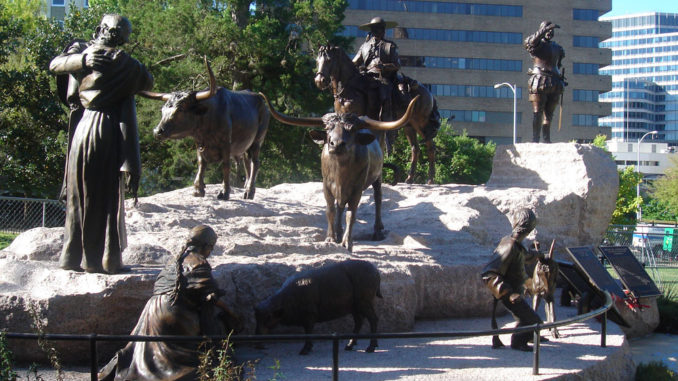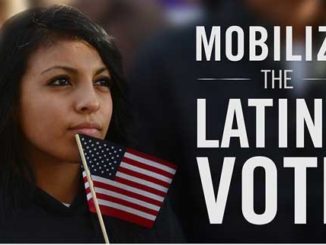
Unqualified authors spew falsehoods, factual errors.
by Rogelio Sáenz
One step forward, three steps back. This exemplifies the world of Mexican-Americans who have fought for Texas to be more inclusive in the teaching of Mexican-American studies in public high schools.
Read more about Mexican Americans from Texas State Historical Association.
A couple of years ago, educators and advocates of Mexican-American studies cheered when the State Board of Education voted in favor of the creation of instructional resources for the teaching of the subject. The exuberance eroded the past few weeks as the Texas Education Agency released its samples of materials to teach Mexican-American studies.
The sole book in the social science category is “Mexican American Heritage.” The book contains very little information about the authors (Jaime Riddle and Valerie Angle) and publisher (Momentum Instruction). The authors are not known as experts in Mexican-American studies, and they lack the appropriate academic credentials.
Background checks reveal that Riddle has an undergraduate degree from Duke University and a graduate degree from Pat Robertson’s Regents University. She is associated with pro-life and Christian causes. Angle does not have an advanced degree but has taken a course on the philosophy of Ayn Rand. Angle markets herself as a “secret weapon” for the “overwhelmed woman.”
Background checks link the publisher to Cynthia Dunbar, a far-right conservative who served on the Texas State Board of Education from 2007 to 2011. She is the author of a book titled “One Nation Under God: How the Left is Trying to Erase What Made Us Great.” Dunbar points out that the goal of her book is for readers to “fervently grasp the biblical function of civic government as it was envisioned by our Founding Fathers.”
A sprinkling of basic errors is found within the span of a few pages. It incorrectly claims that Mexican-Americans moved in large numbers to New York during the World War II era; that Operation Bootstrap created a guest-worker program, and had relevancy to Cubans and Central Americans; that Cubans became the second-largest and Puerto Ricans the third-largest group of Latinos in 1960 (in fact, the order is reversed); and that Puerto Ricans were driven to the U.S. mainland by a “Communist takeover” in the 1960s.
The long history of Mexican-Americans in the United States is largely ignored. Mexican-Americans are presented largely as immigrants who resist learning English and being part of the United States. The authors view “illegal immigration” as the cause of “economic and security problems” and “poverty, non-assimilation, drugs, crime, and exploitation.”
The authors also are highly critical of the Chicano movement of the 1960s and 1970s, arguing that the movement and its adherents sought to destroy U.S. society and reclaim lands that Mexico lost to the United States. Oddly, the book includes an entire section devoted to the Cold War and what it dubs the “Sovietizing of Latin America.”
The book also presents a sanitized and whitewashed version of many important events affecting the Mexican-American population. For example, the Zoot Suit Riots involving the beating of Mexican-Americans in Los Angeles is presented in a few general sentences omitting much detail. The Felix Longoria incident is mentioned in passing, devoid of specifics on why the decorated World War II soldier, denied a wake service, was buried in Arlington National Cemetery.
The book also features great exaggeration. Mexican-Americans are presented as graduating from prominent universities between 1880 and 1930. The book claims that during the 1950s, “more money suddenly became available for scholarships and financial aid to help communities like Mexican-Americans,” and that after World War II, “every American president decided to aid the crusade for political and social equality among American minorities.” It is asserted that the Brown vs. Board of Education decision (1954) dealt “a death blow to Jim Crow laws and segregation practices.” The authors suggest Mexican-Americans and Latinos are now “well-represented in the U.S. government on local, state, and federal levels.”
What the authors say about Latinos clashes with the reality of governmental policies that have turned back the clock on voting rights, school desegregation and more.
The authors cheerfully proclaim, “Both federal and state governments are motivated to help minorities succeed, and are willing to allocate many resources to aid them. Governments sponsor Latino scholarships, loans, and financial aid. They provide welfare for poor families and subsidize Latino advocacy groups, such as the National Council of La Raza.”
Somehow, the Texas Legislature has not received this memo.
While the book’s title focuses on Mexican-Americans, the authors essentially treat Mexican-Americans and Latinos interchangeably. More disturbing is that only a portion of the book focuses on Mexican-Americans.
An analysis of photographs and sidebars show that whites rather than Mexican-Americans disproportionately adorn the book. The book includes 115 pictures of identifiable people. Of these, only 14 are of Mexican-Americans. There are 32 photos of whites, 27 of Mexicans (from Mexico), 14 of Latin Americans, 12 of Europeans, and 16 of others. And Mexican-American women are missing, featured in only seven of the total of 186 photos and sidebars.
The book includes 71 sidebars featuring identifiable persons. Of the 71 sidebars, only 13 concern Mexican-Americans. The book contains 27 sidebars of whites; eight of Mexicans; six each of Europeans, Latin Americans, and Spaniards; and five of others.
The book is largely devoid of citations to support the authors’ writing. Aside from 61 references for particular sidebars containing verbatim passages from original sources, only 28 citations are included to support writings in the remaining 416 pages. The vast majority (21) of the 28 citations are from materials first published more than a century ago; only three are from works published since 2000. Only one source comes from the research of Latinos.
Mexican-Americans — and more broadly, Latinos — have been commonly excluded from the teaching of U.S. and Texas history. Despite the long presence of Mexican-Americans in the U.S., they are routinely treated as an invisible group that has made minimal contributions to the history, culture and economy of this country.
As a way to be more inclusive of the Mexican-American experience, the State Board of Education voted for the creation of instructional materials for teaching Mexican-American studies. Through their book “Mexican American Heritage,” Angle, Dunbar and Riddle have warped, misrepresented and blemished the Mexican-American experience.
Hopefully, educators in school districts throughout Texas will see the sham that “Mexican American Heritage” represents and decide not to adopt it.
Rogelio Sáenz is dean of the College of Public Policy and holds the Mark G. Yudof Endowed Chair at the University of Texas at San Antonio. He is the co-author of “Latinos in the United States: Diversity and Change.”



